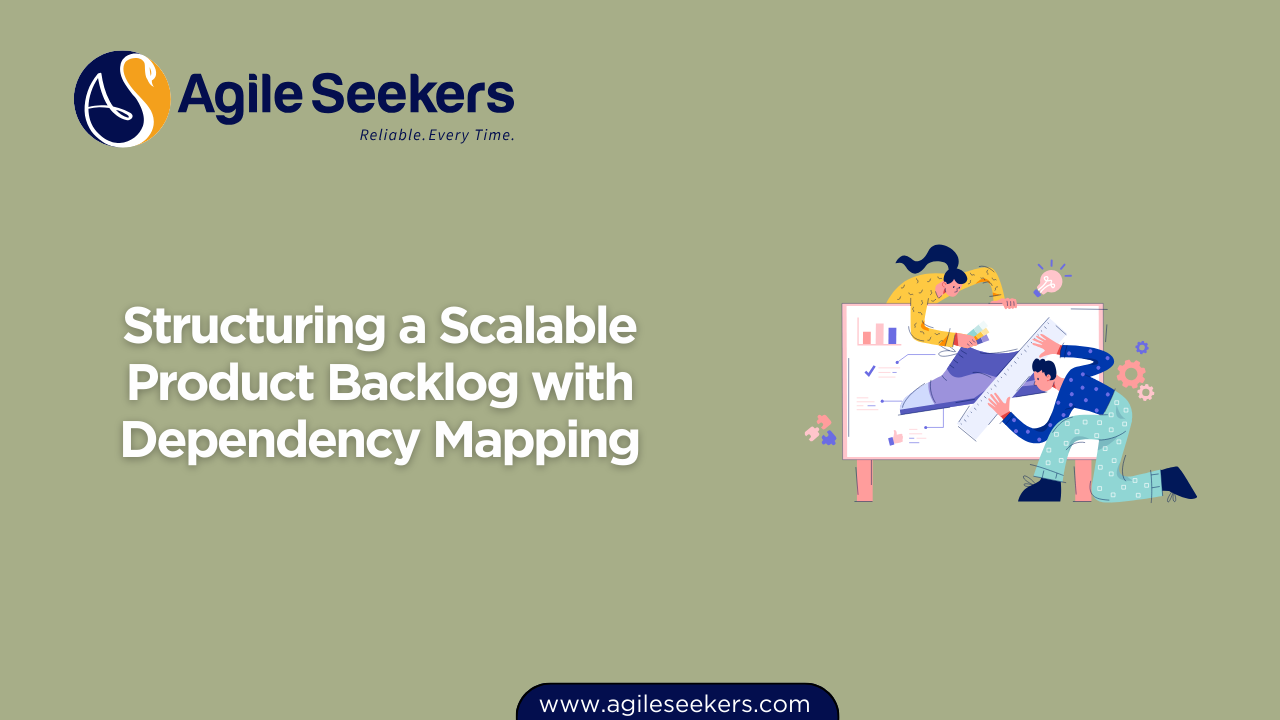Structuring a Scalable Product Backlog with Dependency Mapping

Managing a product backlog becomes significantly more complex as teams scale, especially in multi-team environments. Without a clear structure and dependency visibility, priorities get distorted, delivery slows down, and value gets lost in translation. Structuring a scalable product backlog with dependency mapping can resolve these challenges by aligning delivery with strategy, managing risk, and optimizing throughput.
What Makes a Product Backlog Scalable?
A scalable product backlog is more than a list of user stories. It reflects a prioritized and decomposed view of work aligned to the product vision, strategic themes, and customer outcomes. When multiple teams are working in parallel—across products, systems, or releases—the backlog must adapt to:
- Cross-functional team dependencies
- Program-level alignment and coordination
- Rolling-wave planning cycles
- Capacity across delivery streams
Frameworks like SAFe POPM Certification emphasize the importance of layered backlogs—team, program, and portfolio—each governed by its own prioritization mechanism and dependency logic.
Why Dependency Mapping Matters
Dependencies are one of the biggest obstacles to flow in large-scale agile product delivery. When not mapped clearly, they can result in:
- Blocked work in progress
- Misaligned releases
- Rework due to unmet assumptions
- Hidden risk across teams and systems
Effective dependency mapping provides visibility into sequencing, timing, and ownership—enabling teams to plan collaboratively and deliver predictably.
Core Principles for Structuring a Scalable Backlog
1. Create a Hierarchical Backlog Structure
Organize your backlog into levels that match your product planning scope:
- Epics: Large initiatives aligned to business outcomes
- Capabilities/Features: Functional slices that deliver value
- Stories: Team-level work that enables features
This top-down decomposition approach aligns with PMP Certification principles, particularly in work breakdown structures used for project scope planning.
2. Identify and Visualize Dependencies Early
When a feature or story depends on another, mark it clearly using:
- Custom fields (e.g., “blocked by,” “depends on”)
- Tagging conventions or colored labels
- Dependency matrices or visual boards
Tools like Jira, Aha!, and Targetprocess allow visualization of these links at different levels of granularity.
3. Synchronize Across Teams and Streams
Align your backlog cadence with your planning intervals (e.g., Program Increment in SAFe, Quarterly Release Planning in hybrid models). This ensures backlog items, dependencies, and priorities are revisited and refined together across teams.
Practices from SAFe Product Owner/Manager Certification support this approach with PI planning, ART syncs, and system demos that surface and resolve dependencies collaboratively.
4. Use Dependency Boards or Heatmaps
Visual tools can help product managers and scrum masters see hotspots where work may bottleneck. Common practices include:
- Color-coded boards to flag risk areas
- Dependency lines in roadmaps
- Critical path diagrams for high-risk features
This enables proactive risk management rather than reactive issue handling.
5. Balance Long-Term Planning with Flexibility
Over-structuring the backlog can lead to rigidity. While mapping dependencies, maintain flexibility by:
- Focusing on near-term commitments and mid-term options
- Decoupling delivery where possible (API-first design, mocks, feature flags)
- Using architectural runway to support evolving solutions
Techniques for Mapping Dependencies
| Technique | Use Case | Tools |
|---|---|---|
| Dependency Matrix | Simple cross-check of features/stories | Excel, Google Sheets |
| Roadmap Linkage | Feature alignment across releases | Aha!, ProductPlan |
| Gantt Chart with Dependencies | Waterfall/Hybrid planning environments | MS Project, Smartsheet |
| Agile Board with Linked Issues | Team-level sprint planning | Jira, Azure Boards |
Common Pitfalls to Avoid
- Hard-coding dependencies without fallback options
- Ignoring system-level dependencies in backlog refinement
- Overloading the backlog with non-actionable items
- Failing to review dependencies during iteration and PI planning
Effective backlog management is not about exhaustive detail, but about ensuring teams understand what’s connected and what can move independently.
Dependency Management in Agile Frameworks
Agile at scale places a strong emphasis on managing dependencies at every level:
- In SAFe, the Program Board visualizes cross-team dependencies during PI Planning
- LeSS encourages feature team structures that reduce external dependencies
- Nexus recommends a Nexus Sprint Backlog to track shared work
For professionals preparing for PMP training, these approaches echo integrated change control and risk response planning used in traditional project management.
Bringing It All Together
Structuring a scalable product backlog with dependency mapping bridges strategy and execution. It enhances flow, reduces risk, and empowers teams to deliver value incrementally. Whether you’re working with Scrum, SAFe, or a hybrid model, embedding dependency awareness into your backlog is essential to long-term agility.
If you're looking to strengthen your backlog management skills, consider SAFe POPM Training or formalizing your project planning capabilities through Project Management Professional certification.
For deeper insights into how product managers approach backlog health, you can explore Atlassian's Agile backlog best practices or the Product Development Flow principles by Don Reinertsen.
Also read - Using Cohort Analysis to Inform Retention Strategies
Also see - Leveraging Product Usage Heatmaps for UX Improvements




















